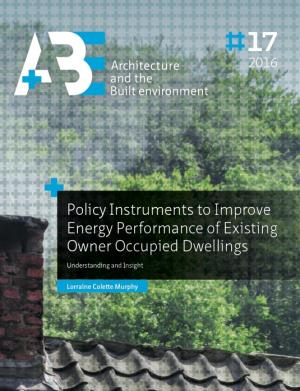Hosted by
Policy Instruments to Improve Energy Performance of Existing Owner Occupied Dwellings: Understanding and Insight
Synopsis
The aim of this thesis is to add knowledge to the role and impact of policy instruments in meeting energy performance ambition in the existing owner occupied housing stock. The focus was instruments available in the Netherlands in 2011 and 2012. These instruments represented the ‘on the ground’ efforts to meet climate change targets and many continue to do so today in the same or slightly altered forms.
At international level there is a recognized need to keep global temperatures within the range of 1.5 - 2°C above pre-industrial levels (Carrington, 2016). At European level, the 2020 package contains a series of binding legislation to help the EU meet its more immediate climate and energy targets. 2020 targets include 20% reduction in greenhouse gas emission, 20% of EU energy obtained from renewable sources and 20% improvement in energy efficiency. 2020 targets for the Netherlands are a 20% reduction in greenhouse gas emissions and a 14% increase in energy generation from renewable sources (Vringer et al., 2014).
A raft of policies has been produced over the last number of decades from international to local level to orientate action towards targets. At European level the Energy Performance of Buildings Directive (EPBD) drives efforts at reducing energy among one of the biggest players, the building sector. By requiring a mandatory certificate at the point of sale and rent of buildings and making regulatory demands on existing buildings the EPBD upped the ante of what could be expected from the building sector, but especially the existing dwelling stock.
National governments have already been tackling existing dwellings for decades propelled by the energy crisis and later by climate change policy. Information campaigns, subsidies, energy taxes, energy loans and tailored advice are among the instruments that have been available to homeowners to carry out works on their dwellings to reduce energy consumption. In recent years, the pace of efforts has increased due to, inter alia, the realization that the revolution in energy use that must occur for climate change targets to be met means major changes in the fabric of the existing dwelling stock, dwellings constructed before building regulations demanded high energy performance standards. It is argued that the building sector, in general, and the existing dwelling stock, in particular, can contribute more cost effectively and more significantly in quality and quantity terms than any other sector (Amstalden et al., 2007; Lomas, 2010; íœrge-Vorsatz, et al., 2007). This has provoked calls for new and improved instruments to meet the energy saving potential of existing dwellings.
Despite many of the same instruments being used for decades there is little solid information on many crucial dimensions of how instruments operate and on what impact they have. The few evaluations and reviews that do take place are commonly focused on theoretical energy savings and costs and instrument strengths and weaknesses. Instruments commonly appear and disappear without undergoing improvement or change or contributing to policy learning. Many instruments are laden with assumptions about the target group that are never formally or comprehensively proved or debunked. Little theorizing takes place on the type of instruments most suited to the target group. Fundamentally, there is a serious lack of information surrounding the effectiveness of instruments assumed to be making climate change targets a reality.
It is the above mentioned information deficits that influenced the objectives and structure of this thesis. Instruments are examined from different angles and viewpoints, from experts, owner occupiers, official evaluations and front-runner countries. Assessment frameworks were developed to tease out how well instruments truly function. Households in receipt of instruments such as the EPC and energy audit were compared to households not in receipt of instruments. Moreover, the complete range of national instruments available at the time of the survey were studied to present a complete picture.

